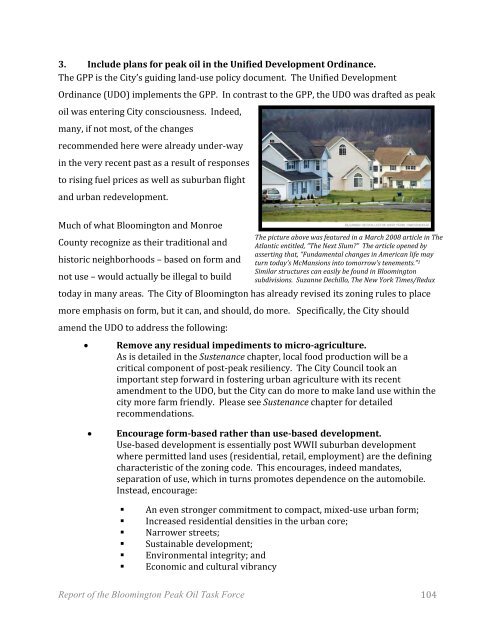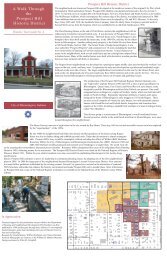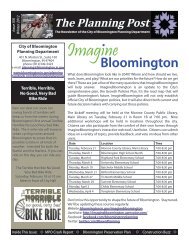Peak Oil Task Force Report - City of Bloomington - State of Indiana
Peak Oil Task Force Report - City of Bloomington - State of Indiana
Peak Oil Task Force Report - City of Bloomington - State of Indiana
Create successful ePaper yourself
Turn your PDF publications into a flip-book with our unique Google optimized e-Paper software.
3. Include plans for peak oil in the Unified Development Ordinance.<br />
The GPP is the <strong>City</strong>’s guiding land‐use policy document. The Unified Development<br />
Ordinance (UDO) implements the GPP. In contrast to the GPP, the UDO was drafted as peak<br />
oil was entering <strong>City</strong> consciousness. Indeed,<br />
many, if not most, <strong>of</strong> the changes<br />
recommended here were already under‐way<br />
in the very recent past as a result <strong>of</strong> responses<br />
to rising fuel prices as well as suburban flight<br />
and urban redevelopment.<br />
Much <strong>of</strong> what <strong>Bloomington</strong> and Monroe<br />
County recognize as their traditional and<br />
historic neighborhoods – based on form and<br />
not use – would actually be illegal to build<br />
today in many areas. The <strong>City</strong> <strong>of</strong> <strong>Bloomington</strong> has already revised its zoning rules to place<br />
more emphasis on form, but it can, and should, do more. Specifically, the <strong>City</strong> should<br />
amend the UDO to address the following:<br />
<strong>Report</strong> <strong>of</strong> the <strong>Bloomington</strong> <strong>Peak</strong> <strong>Oil</strong> <strong>Task</strong> <strong>Force</strong><br />
The picture above was featured in a March 2008 article in The<br />
Atlantic entitled, “The Next Slum?” The article opened by<br />
asserting that, “Fundamental changes in American life may<br />
turn today’s McMansions into tomorrow’s tenements.” 1<br />
Similar structures can easily be found in <strong>Bloomington</strong><br />
subdivisions. Suzanne Dechillo, The New York Times/Redux<br />
• Remove any residual impediments to microagriculture.<br />
As is detailed in the Sustenance chapter, local food production will be a<br />
critical component <strong>of</strong> post‐peak resiliency. The <strong>City</strong> Council took an<br />
important step forward in fostering urban agriculture with its recent<br />
amendment to the UDO, but the <strong>City</strong> can do more to make land use within the<br />
city more farm friendly. Please see Sustenance chapter for detailed<br />
recommendations.<br />
• Encourage formbased rather than usebased development.<br />
Use‐based development is essentially post WWII suburban development<br />
where permitted land uses (residential, retail, employment) are the defining<br />
characteristic <strong>of</strong> the zoning code. This encourages, indeed mandates,<br />
separation <strong>of</strong> use, which in turns promotes dependence on the automobile.<br />
Instead, encourage:<br />
An even stronger commitment to compact, mixed‐use urban form;<br />
Increased residential densities in the urban core;<br />
Narrower streets;<br />
Sustainable development;<br />
Environmental integrity; and<br />
Economic and cultural vibrancy<br />
104









